|
Atyphella Atra
''Atyphella atra'' is a species of firefly The Lampyridae are a family of elateroid beetles with more than 2,000 described species, many of which are light-emitting. They are soft-bodied beetles commonly called fireflies, lightning bugs, or glowworms for their conspicuous production ... in the genus '' Atyphella''. It was discovered by Lea in 1921.Ballantyne & Lambkin, 2009 References Lampyridae Beetles described in 1921 {{Firefly-stub ... [...More Info...] [...Related Items...] OR: [Wikipedia] [Google] [Baidu] |
Firefly
The Lampyridae are a family of elateroid beetles with more than 2,000 described species, many of which are light-emitting. They are soft-bodied beetles commonly called fireflies, lightning bugs, or glowworms for their conspicuous production of light, mainly during twilight, to attract mates. Light production in the Lampyridae is thought to have originated as an honest warning signal that the larvae were distasteful; this was co-opted in evolution as a mating signal in the adults. In a further development, female fireflies of the genus ''Photuris'' mimic the flash pattern of ''Photinus'' species to trap their males as prey. Fireflies are found in temperate and tropical climates. Many live in marshes or in wet, wooded areas where their larvae have abundant sources of food. While all known fireflies glow as larvae, only some species produce light in their adult stage, and the location of the light organ varies among species and between sexes of the same species. Fireflies ha ... [...More Info...] [...Related Items...] OR: [Wikipedia] [Google] [Baidu] |
Atyphella
''Atyphella'' is a genus of 'flashing' firefly (family Lampyridae) found in the Australasian region, particularly in the eastern and northern regions of Australia. The genus consists of 23 recognized species, 14 considered to be endemic to Australia.Ballantyne & Lambkin, 2006 Description The larval stage of ''Atyphella'' is morphologically similar to the ''Luciola'' larval stage, the key difference being that the ''Atyphella'' possess a series of flat projections on the sides of the body (known as explanate tergites).Ballantyne, 1987 ''Atyphella'' antennae are relatively short, shorter than the widest part of the head. This is almost unique among the genera of the subfamily Luciolinae with '' Bourgeoisia'' being the only other to feature this. The adult ''Atyphella'' head is concealed under an extended pronotum and recessed into the prothoracic cavity. This effectively eliminates upwards vision when in flight and in a resting state. However, it has been observed that some spec ... [...More Info...] [...Related Items...] OR: [Wikipedia] [Google] [Baidu] |
Lampyridae
The Lampyridae are a family (biology), family of Elateroidea, elateroid beetles with more than 2,000 described species, many of which are bioluminescence, light-emitting. They are soft-bodied beetles commonly called fireflies, lightning bugs, or glowworms for their conspicuous production of light, mainly crepuscular, during twilight, to attract mates. Light production in the Lampyridae is thought to have originated as an honest signal, honest Aposematism, warning signal that the larvae were distasteful; this was co-opted in evolution as a mating signal in the adults. In a further development, female fireflies of the genus ''Photuris'' mimic the flash pattern of ''Photinus (beetle), Photinus'' species to trap their males as prey. Fireflies are found in temperate and tropical climates. Many live in marshes or in wet, wooded areas where their larvae have abundant sources of food. While all known fireflies glow as larvae, only some species produce light in their adult stage, and ... [...More Info...] [...Related Items...] OR: [Wikipedia] [Google] [Baidu] |

